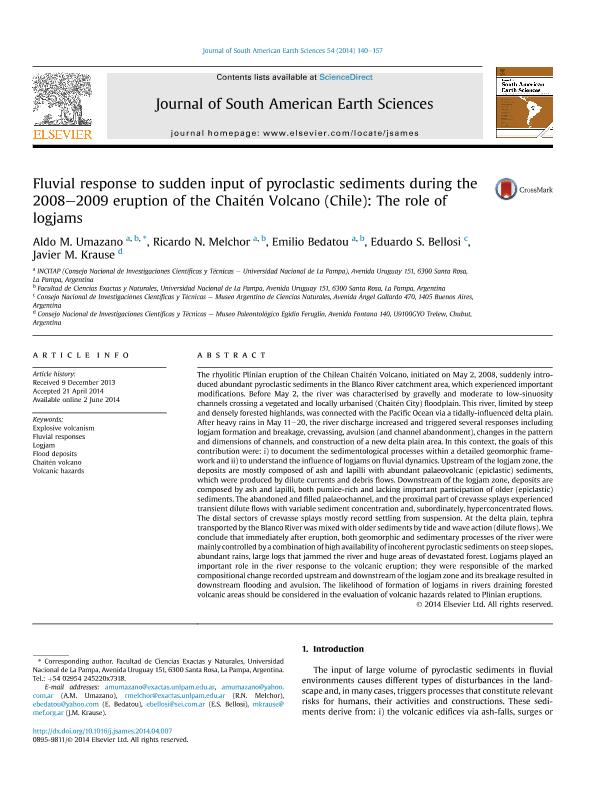Artículo
Fluvial response to sudden input of pyroclastic sediments during the 2008–2009 eruption of the Chaitén Volcano (Chile): The role of logjams
Umazano, Aldo Martin ; Melchor, Ricardo Nestor
; Melchor, Ricardo Nestor ; Bedatou, Emilio
; Bedatou, Emilio ; Bellosi, Eduardo Sergio
; Bellosi, Eduardo Sergio ; Krause, Javier Marcelo
; Krause, Javier Marcelo
 ; Melchor, Ricardo Nestor
; Melchor, Ricardo Nestor ; Bedatou, Emilio
; Bedatou, Emilio ; Bellosi, Eduardo Sergio
; Bellosi, Eduardo Sergio ; Krause, Javier Marcelo
; Krause, Javier Marcelo
Fecha de publicación:
10/2014
Editorial:
Elsevier
Revista:
Journal of South American Earth Sciences
ISSN:
0895-9811
Idioma:
Inglés
Tipo de recurso:
Artículo publicado
Clasificación temática:
Resumen
The rhyolitic Plinian eruption of the Chilean Chaitén Volcano, initiated on May 2, 2008, suddenly introduced abundant pyroclastic sediments in the Blanco River catchment area, which experienced important modifications. Before May 2, the river was characterised by gravelly and moderate to low-sinuosity channels crossing a vegetated and locally urbanised (Chaitén City) floodplain. This river, limited by steep and densely forested highlands, was connected with the Pacific Ocean via a tidally-influenced delta plain. After heavy rains in May 11–20, the river discharge increased and triggered several responses including logjam formation and breakage, crevassing, avulsion (and channel abandonment), changes in the pattern and dimensions of channels, and construction of a new delta plain area. In this context, the goals of this contribution were: i) to document the sedimentological processes within a detailed geomorphic framework and ii) to understand the influence of logjams on fluvial dynamics. Upstream of the logjam zone, the deposits are mostly composed of ash and lapilli with abundant palaeovolcanic (epiclastic) sediments, which were produced by dilute currents and debris flows. Downstream of the logjam zone, deposits are composed by ash and lapilli, both pumice-rich and lacking important participation of older (epiclastic) sediments. The abandoned and filled palaeochannel, and the proximal part of crevasse splays experienced transient dilute flows with variable sediment concentration and, subordinately, hyperconcentrated flows. The distal sectors of crevasse splays mostly record settling from suspension. At the delta plain, tephra transported by the Blanco River was mixed with older sediments by tide and wave action (dilute flows). We conclude that immediately after eruption, both geomorphic and sedimentary processes of the river were mainly controlled by a combination of high availability of incoherent pyroclastic sediments on steep slopes, abundant rains, large logs that jammed the river and huge areas of devastated forest. Logjams played an important role in the river response to the volcanic eruption; they were responsible of the marked compositional change recorded upstream and downstream of the logjam zone and its breakage resulted in downstream flooding and avulsion. The likelihood of formation of logjams in rivers draining forested volcanic areas should be considered in the evaluation of volcanic hazards related to Plinian eruptions.
Archivos asociados
Licencia
Identificadores
Colecciones
Articulos(INCITAP)
Articulos de INST.D/CS D/L/TIERRA Y AMBIENTALES D/L/PAMPA
Articulos de INST.D/CS D/L/TIERRA Y AMBIENTALES D/L/PAMPA
Articulos(MACNBR)
Articulos de MUSEO ARG.DE CS.NAT "BERNARDINO RIVADAVIA"
Articulos de MUSEO ARG.DE CS.NAT "BERNARDINO RIVADAVIA"
Articulos(SEDE CENTRAL)
Articulos de SEDE CENTRAL
Articulos de SEDE CENTRAL
Citación
Umazano, Aldo Martin; Melchor, Ricardo Nestor; Bedatou, Emilio; Bellosi, Eduardo Sergio; Krause, Javier Marcelo; Fluvial response to sudden input of pyroclastic sediments during the 2008–2009 eruption of the Chaitén Volcano (Chile): The role of logjams; Elsevier; Journal of South American Earth Sciences; 54; 10-2014; 140-157
Compartir
Altmétricas



